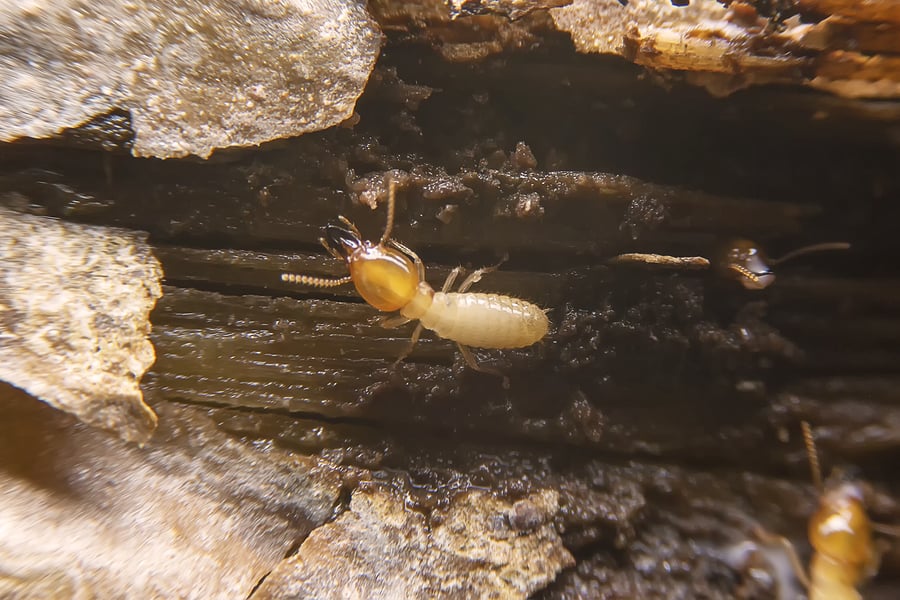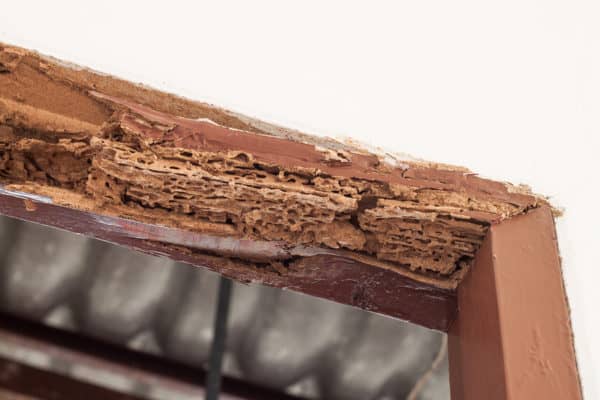READY TO GET STARTED?
REQUEST A FREE ESTIMATE
Fill out the form below or call (888) 466-7849 for a free, no-obligation estimate.

Buying a home is a major investment and, for most homeowners, a lot of time is spent repairing and renovating their house to their liking. Home ownership can also bring unexpected problems that can be costly to repair, such as a subterranean termite infestation. Subterranean termites are known to cause considerable damage by building tunnels to reach food sources. Termites can colonize homes and cause significant undetected destruction over a long period of time. The cost to repair the damage can be in the thousands of dollars. Unfortunately, termite infestations can sometime be caused by the homeowner!
Improper Drainage
Having improper drainage around your home is one of the most common reasons why termites have infested. Subterranean termites are attracted to moisture and need an abundant source of nearby water to survive. Clogged gutters can cause water to pool and make insulation vulnerable to termites. Leaves, twigs, and other debris can build up in the home’s gutters, while the excess moisture can soften your roof and cause it to rot. Try to divert rainwater away from your foundation with a down-spout and by having splash blocks that will prevent water from pooling.
Wood Mulch
Landscaping and crafting a beautiful yard come with having a home, though, sometimes the type of materials used to landscape is attracting termites. Mulch is often used near and around the house, usually against the foundation. Unfortunately, mulch can serve as a source of food for termites as they retain moisture, attracting these pests right to the edge of your home. Try to minimize the use of wood mulch and keep it at least 15 inches from the foundation.
Moisture
Lack of airflow and leaking pipes all contribute to moisture problems in the home and can create conditions beneficial to termites. Eliminating any type of excess moisture inside the home is a major step in preventing termites from infesting. Consider enclosing your crawlspace to not only prevent these termites and other pests but also improve the overall health of your home by reducing the moisture, decreasing humidity, lowering utility bills, and preventing mold and wood rot.
If you have taken these necessary steps in preventing termites but suspect that you might have a termite problem, consider calling your local pest control company to help. They will set you up with a termite inspection and a treatment and prevention plan.

It is estimated that termites cause billions of dollars worth of damage in the United States annually. While they primarily feed on wood, they can also damage books, insulation, and even swimming pool liners and filters. They can wreak havoc on trees and shrubs and are particularly fond of plants that are in bad health. Termites can infest buildings at any time. This can be particularly troublesome when buying or selling a home. A termite inspection and report are usually required as a condition of sale of a home.
There are several different species of termites but the two most common are drywood and subterranean termites. Formosan termites are the most prevalent species of subterranean termites in the southeastern US. Drywood termites don’t cause the extensive damage that subterranean termites do. Drywood termites cost property owners hundreds of millions of dollars in damage and repairs each year; subterranean termite damage is in the billions. This is due in part to drywood termites having smaller colonies, so it takes them longer to cause damage. Drywood termites are also more visible than subterranean ones – they tend to kick their dried feces out onto surfaces as they eat, making them easier to spot. Subterranean termites keep their droppings inside their tunnels so they are more likely to go unnoticed. Subterranean termites can also have multiple colonies near a home which can all feed on the same home at the same time, exponentially increasing the number of termites infesting the structure.
Termites destroy homes by eating wood and wood products. They have special enzymes, bacteria, and protozoa in their guts that allow them to digest cellulose (organic fibrous material in wood and plants). The largest subterranean termite colonies can eat up to a pound of wood per day. This damage, however, often goes unnoticed for many years. Because they slowly eat away at the wood inside your home, often without your knowledge, termite damage often severely impacts the structural integrity of your home. Termite colonies can take 3 to 5 years to fully mature. While there is no accurate way of calculating the exact age of an infestation, there are ways to make accurate predictions of their age. It can take anywhere from 3 to 8 years for termite damage to show up depending on the size of the colony.
When signs of termite damage surface, there has often been an infestation for years with extensive damage already sustained. Some signs of a termites in your home include:
Significant damage from termites can have an effect on the structural integrity of your home and can even cause ceilings and floors to collapse. Termites can also ruin furniture, carpeting, and flooring.
There is no central agency that monitors or tracks termite damage data. Many pest control companies report their data to state agricultural and academic experts but there is no system in place for uniform tracking across the country. Therefore, most damage cost estimates are based on estimates. It is estimated that:
One question many homeowners have is if termite damage is covered under a homeowner’s insurance policy. Unfortunately in most cases the answer to this question is no. Homeowner’s insurance typically does not cover termite damage or removal because it can usually be prevented through routine home maintenance. However, you should always check with your insurance provider to see what you are and are not covered for.
Since insurance usually doesn’t cover termite damage and repair, what is the average cost to repair termite damage? The cost of repairs varies greatly from case to case and is dependent on a variety of factors such as how much wood the termites have eaten, how long the colony has been in the home, and where the damage was done inside the home. Repairs can often be more expensive than the original building costs, often in the thousands of dollars. In rare cases termite damage can be so extensive that the home is completely demolished. In addition to the structural repairs that have to be made, cosmetic repairs also have to be made. Termites can cause discoloration and other damage to sheetrock, flooring and paint which will also need repair or replacement. The cost of these will vary on an individual basis but some repairs will be more costly than others, e.g. replacing hardwood floors versus floor tiles. Exterminator costs also have to be factored in as the termites have to be controlled and eliminated before any repairs can be done. The costs will vary depending on your termite control professional but will usually include the cost of chemicals and baits, labor, and service and can vary based on your location and the type of termite treatment you choose.
Termites can be prevented with scheduled periodic professional inspections which can help identify signs of infestations earlier, keeping damage minimal and repair costs down. Any professional termite control plan should eliminate termites, prevent future termite infestations, and prevent termite damage. If you suspect you have a termite problem or want to have an inspection done to check for termites, contact us for a free estimate.
How Do You Get Your Lawn Ready For Spring?
What Attracts Cockroaches To Your Home?
Spring Swarmers: How To Prepare For Termite Season
5 Ways To Prevent Bed Bugs When Traveling
Mice, Rats, And Other Problem Rodents